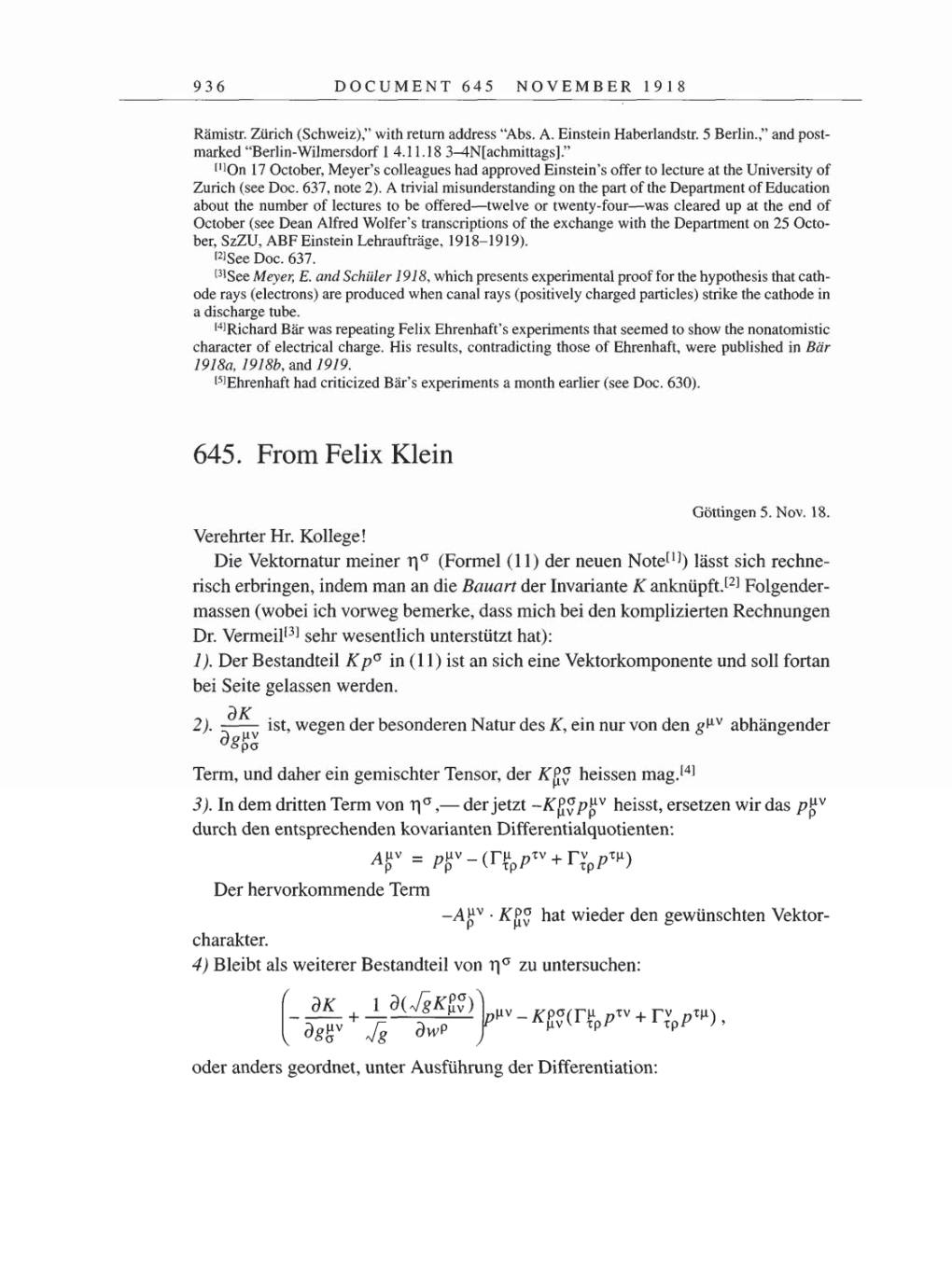936 DOCUMENT 645 NOVEMBER 1918
Rämistr. Zürich
(Schweiz),"
with
return
address "Abs. A. Einstein Haberlandstr.
5 Berlin.,"
and
post-
marked
"Berlin-Wilmersdorf
1
4.11.18 3-4N[achmittags]."
[1]On 17 October,
Meyer’s colleagues
had
approved
Einstein’s offer to lecture at the
University
of
Zurich
(see
Doc.
637, note 2).
A trivial
misunderstanding on
the
part
of
the
Department
of
Education
about the number
of
lectures
to
be
offered-twelve
or
twenty-four-was
cleared
up
at
the end
of
October
(see
Dean Alfred Wolfer’s
transcriptions
of
the
exchange
with the
Department on
25 Octo-
ber, SzZU,
ABF
Einstein
Lehraufträge,
1918-1919).
[2]See
Doc. 637.
[3]See
Meyer,
E.
and Schüler
1918,
which
presents experimental
proof
for the
hypothesis
that cath-
ode
rays (electrons) are produced
when canal
rays (positively charged particles)
strike the cathode in
a discharge
tube.
[4]Richard Bär
was repeating
Felix Ehrenhaft’s
experiments
that seemed
to
show the nonatomistic
character
of
electrical
charge.
His
results,
contradicting
those
of
Ehrenhaft,
were published
in
Bär
1918a, 1918b,
and 1919.
[5]Ehrenhaft had criticized Bär’s
experiments a
month
earlier
(see
Doc.
630).
645. From Felix Klein
Göttingen
5. Nov.
18.
Verehrter
Hr.
Kollege!
Die Vektornatur meiner
r|®
(Formel (11)
der
neuen
Note[1])
lässt sich rechne-
risch
erbringen,
indem
man
an
die
Bauart
der Invariante K
anknüpft.[2] Folgender-
massen (wobei
ich
vorweg
bemerke,
dass mich bei den
komplizierten Rechnungen
Dr.
Vermeil[3]
sehr
wesentlich unterstützt
hat):
1).
Der Bestandteil Kp° in
(11)
ist
an
sich eine
Vektorkomponente
und soll fortan
bei Seite
gelassen
werden.
2).
dKdguvpa ist,
wegen
der besonderen Natur des
K,
ein
nur von
den
gbv abhängender
Term,
und
daher
ein
gemischter
Tensor,
der
KP®
heissen
mag.[4]
3).
In dem dritten Term
von
t|°,-
der
jetzt
-KP°pj}v
heisst, ersetzen
wir das
pftv
durch den
entsprechenden
kovarianten
Differentialquotienten:
AFV
= p|*v_
(F^pTv
+
rv^)
Der hervorkommende
Term
-APV KP®
hat wieder den
gewünschten
Vektor-
charakter.
4)
Bleibt als weiterer Bestandteil
von
t|ö
zu
untersuchen:
(
1
d(VgKP^
dK
Jg dwP
^v-KP®(rpp^v
+ rvDptp);tpi
oder
anders
geordnet,
unter
Ausführung
der Differentiation:
